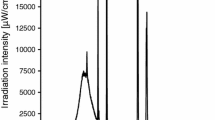Abstract
A novel photocatalytic cement based material was prepared. The distribution of TiO2 on the surface of cement was characterized by scanning electron microscope (SEM) and X-ray diffraction (XRD), which showed the relationship of photocatalysis and presence of TiO2. TiO2 also had an impact on cement hydration, which was studied by thermal analysis. With 300 W UV illuminations, formaldehyde and benzene were degraded efficiently by the prepared photocatalytic cement based materials. 15wt% TiO2/cement showed the highest degradation efficiency and capability. The results show that formaldehyde and benzene can be degraded within 4 and 9 hours, respectively. Besides, inorganic ions can induce TiO2 agglomeration. As a result, the presence of inorganic ions in cement is unfavorable for degradation. The photocatalytic cement based materials were fabricated and the degradation efficiency of formaldehyde was measured on building roof under sunlight illumination. Formaldehyde in glass chamber can be degraded thoroughly within 10 days.
Similar content being viewed by others
References
Fernandez JE. Materials for Aesthetic, Energy-efficient, and Selfdiagnostic Buildings[J]. Science, 2007, 315(5820): 1807–1810
Fujishima A, Zhang X, Tryk D A. TiO2 Photocatalysis and Related Surface Phenomena[J]. Surf. Sci. Rep., 2008, 63(12): 515–582
Aïssa AH, Puzenat E, Plassais A, et al. Characterization and Photocatalytic Performance in Air of Cementitious Materials Containing TiO2. Case Study of Formaldehyde Removal[J]. Appl. Catal. B-Environ., 2011, 107(1): 1–8
Faraldos M, Kropp R, Anderson MA, et al. Photocatalytic Hydrophobic Concrete Coatings to Combat Air Pollution[J]. Catal. Today, 2016, 259: 228–236
Pham TD, Lee BK. Disinfection of Staphylococcus Aureus in Indoor Aerosols Using Cu-TiO2 Deposited on Glass Fiber under Visible Light Irradiation[J]. J. Photoch. Photobio. A, 2015, 307: 16–22
Zhao J, Yang X. Photocatalytic Oxidation for Indoor Air Purification: A Literature Review[J]. Build. Environ., 2003, 38(5): 645–654
Wang F, Yang L, Wang H, et al. Facile Preparation of Photocatalytic Exposed Aggregate Concrete with Highly Efficient and Stable Catalytic Performance[J]. Chem. Eng. J., 2015, 264: 577–586
Ruot B, Plassais A, Olive F, et al. TiO2-containing Cement Pastes and Mortars: Measurements of the Photocatalytic Efficiency Using a Rhodamine B-based Colourimetric Test[J]. Sol. Energy, 2009, 83(10): 1794–1801
Peng Yining G, Fazhou W, et al. Photocatalytic Activity of Portland Cement Loaded with 3D Hierarchical Bi2WO6 Microspheres under Visible Light[J]. Construction and Building Materials, 2016: 120: 42–47
Fazhou W, Guoxin S, Wenqin Z, et al. Performance of Photocatalytic Cementitious Material: Influence of Substrate Surface Microstructure[J]. Construction and Building Materials, 2016, 110: 175–181
Zhu Z, Wu RJ. The Degradation of Formaldehyde Using a Pt@TiO2 Nanoparticles in Presence of Visible Light Irradiation at Room Temperature[J]. J. Taiwan. Inst. Chem. E, 2015, 50: 276–281
LI Z, WANG X, GAO D, et al. Experimental Investigation on Setting Property of Magnesium Oxysulfate Cement[J]. Bulletin of the Chinese Ceramic Society, 2015, 34: 1215–1218
Pinho L, Mosquera MJ. Photocatalytic Activity of TiO2-SiO2 Nanocomposites Applied to Buildings: Influence of Particle Size and Loading[J]. Appl. Catal. B-Environ., 2013, 134: 205–221
Zhang R, Cheng X, Hou P, et al. Influences of Nano-TiO2 on the Properties of Cement-based Materials: Hydration and Drying Shrinkage[J]. Constr. Build. Maters., 2015, 81: 35–41
Kong D, Su Y, Du X, et al. Influence of Nano-silica Agglomeration on Fresh Properties of Cement Pastes[J]. Constr. Build. Maters., 2013, 43: 557–562
Suraneni P, Flatt RJ. Use of Micro-reactors to Obtain New Insights into the Factors Influencing Tricalcium Silicate Dissolution[J]. Cement Concrete Res., 2015, 78: 208–215
Gutteridge WA, Dalziel JA. Filler Cement: the Effect of the Secondary Component on the Hydration of Portland Cement: Part I. A Fine Nonhydraulic Filler[J]. Cement Concrete Res., 1990, 20(5): 778–782
Ye G, Liu X, De Schutter G, et al. Influence of Limestone Powder Used as Filler in SCC on Hydration and Microstructure of Cement Pastes[J]. Cement Concrete Comp., 2007, 29(2): 94–102
Tikkanen J, Cwirzen A, Penttala V. Effects of Mineral Powders on Hydration Process and Hydration Products in Normal Strength Concrete[J]. Constr. Build. Maters., 2014, 72: 7–14
de Andrade FV, de Lima GM, Augusti R, et al. A novel TiO2/Autoclaved Cellular Concrete Composite: From a Precast Building Material to a New Floating Photocatalyst for Degradation of Organic Water Contaminants[J]. Journal of Water Process Engineering, 2015, 7: 27–35
Enevoldsen JN, Hansson CM, Hope BB. Binding of Chloride in Mortar Containing Admixed or Penetrated Chlorides[J]. Cement Concrete Res., 1994, 24(8): 1525–1533
Mei J, Mao J, Chen Z, et al. Mechanism and Kinetics of 4-hydroxy-2-Butanone Formation from Formaldehyde and Acetone under Supercritical Conditions and in High-temperature Liquid-phase[J]. Chem. Eng. Sci., 2015, 131: 213–218
Author information
Authors and Affiliations
Corresponding author
Additional information
Funded by the National Natural Science Foundation of China (Nos. 51478370 and 51461135005)
Rights and permissions
About this article
Cite this article
Liu, P., Yu, X., Wang, F. et al. Degradation of formaldehyde and benzene by TiO2 photocatalytic cement based materials. J. Wuhan Univ. Technol.-Mat. Sci. Edit. 32, 391–396 (2017). https://doi.org/10.1007/s11595-017-1608-8
Received:
Accepted:
Published:
Issue Date:
DOI: https://doi.org/10.1007/s11595-017-1608-8




